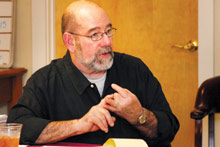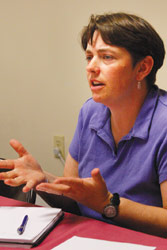Goody Clancy, the Boston-based architectural and planning firm hired to create a downtown master plan for Asheville, has collected its fair share of awards in recent years. But David Dixon, who’s in charge of planning and urban design at the company, says none of those successes would have been possible without extensive public input.

“We can’t just create a great plan sitting here in Boston,” he maintains. “You really have to have the larger community on board. There is a wide range of nuances that could never be found otherwise.”
Two orientation meetings (May 8 and May 15) have already been held, but the rubber will really meet the road May 30 and 31, when participating members of the public will help planners tackle specific issues facing downtown.
A spate of controversial development proposals has kept some of those issues in the spotlight in recent months—notably the appropriate height and span of new downtown structures. In addition, continued development of high-priced condos threatens to squeeze out the artists and indie retailers who have helped make Asheville the attraction it now is, some argue. Other concerns also regularly crop up in City Council meetings and fall from the lips of community activists: walkability, density, affordability, green space and that elusive Asheville factor known as “funkiness.” The trick will be fitting all these pieces together in a way that’s agreeable to the city’s diverse and often sharply divided constituencies.
Building consensus
The pressures created by a changing downtown finally reached critical mass last year when the Downtown Commission, which is charged with making recommendations on new development proposals, asked city leaders for a downtown master plan to help guide such decisions.

“[The commission] said: ‘Hey, city, it’s time to try to get a handle on it. We’re not talking about no growth or pro-growth, but smart growth,’” explains architect Tom Gallaher, a locally based subcontractor who also serves on the Master Plan Advisory Committee.
City Council approved approved the idea, and some months later, Goody Clancy got the contract.
“As part of our interviews [with design firms], at least half of the conversation was, ‘How can you help build consensus in our community?’” says Sasha Vrtunski, the city’s liaison and project manager. “That was probably the biggest factor in the discussion.”
Community buy-in has become a force to be reckoned with in Asheville, and developers who do the legwork to get the public on board with their plans are winning high praise from Council members. So it makes sense that the city would be held to the same standard.
“If the plan isn’t accepted by the community, it isn’t going to be implemented,” Vrtunski emphasizes.
Already, however, fears have emerged that the city might simply ignore whatever plan is produced, Downtown Commission Chair Pat Whalen told Council members during their May 13 meeting.
“[There is a ] community sense of frustration about flaws in past public processes, and reports and plans gathering dust in the basement of City Hall—some of which were passed after considerable delay and others that have never been acted upon,” said Whalen.
Living with it
But despite—or perhaps because of—those concerns about process, turnout at the first two public meetings has been impressive.
The May 8 session pulled in about 350 people: two to three times what Goody Clancy typically sees in other cities, said Whalen. A second meeting, focusing on downtown’s history, drew more than 100 people.
“The need for [a master plan] has been demonstrated by the number of people attending the orientation meetings,” says Gallaher.
And while some citizen activists tend to focus on a particular factor such as building height, broad participation increases the chances of illuminating the bigger picture.
“We’re trying to get everybody to see we are dealing with more than just their own issue,” Gallaher explains. But compromise, he says, is what’s needed to make the whole thing work. “It may be, ‘Can you live with it?’” he continues.
Another concern aired at the May 13 Council meeting is that politically influential groups might show up at the 11th hour and start making demands after others have already done most of the work. That fear, said Whalen, could be soothed by bringing key stakeholders to the table early on, and by Council members’ attendance at the public meetings.
At a May 22 meeting of the advisory committee—a group of community representatives and developers charged with ensuring that the process stays public—members continued to work on how to attract more people to the process. The African-American community has been underrepresented at the public forums so far, they noted—but developers have been too.
Dixon, meanwhile, is well aware that public involvement isn’t limited to information sharing: It’s political as well. And whatever product his company comes up with will need to win elected officials’ approval. Public input, says Dixon, “contributes immensely to creativity and reality—and political support.”
The next public meetings on developing a downtown master plan will be held Friday, May 30, at Asheville Community Theatre (6 to 8 p.m.) and Saturday, May 31, at the Randolph Learning Center (10 a.m. to 3 p.m.). For an updated meeting schedule, go to www.ashevillenc.gov.



What’s the point of any of it since City Council just keeps rubberstamping luxury condo projects month after month after month? So much has already been lost, the “funkiness” has already been so damaged by the yuppie takeover that there won’t be anything worth preserving by the time this process is over. And it’s all because our City Council does not care enough to support a sensible moratorium. Sad. Boulder keeps looking better to me every day.
cities are complex living beings … no development plan can ever take into account all the many variables of people, nature, economy, technology, etc. that impact the growth of cities.
why not just enjoy the ride?